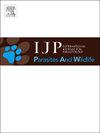Parasite diversity in grey wolves (Canis lupus) from Tuscany, central Italy: a copromicroscopical investigation
IF 2.2
3区 医学
Q3 ECOLOGY
International Journal for Parasitology-Parasites and Wildlife
Pub Date : 2025-05-31
DOI:10.1016/j.ijppaw.2025.101092
引用次数: 0
Abstract
Parasite monitoring is considered an important issue for wildlife conservation as well as for veterinary and public health. In Italy, data on endoparasites of the grey wolf (Canis lupus) are still limited. A copro-microscopical study was performed to investigate endoparasites of grey wolf communities in three Apennine natural reserves and a hilly area in northern Tuscany, central Italy. A total of 66 fresh faecal samples were collected and examined using the Mini-FLOTAC technique with a high-density flotation solution. Apparent prevalence and 95 % confidence intervals (CI) were estimated for each parasite taxon, while true parasite prevalence rates were assessed for individual wolves identified after molecular analyses in one of the three natural areas (Apuan Alps Regional Park, AARP). Overall, a high prevalence of endoparasites was estimated (92.4 %, 95 % CI 83.2–97.5), and most samples were found positive for respiratory capillariids (81.8 %), i.e., Eucoleus boehmi (66.7 %) and Eucoleus aerophilus (31.8 %), Sarcocystis spp. (36.4 %) and hookworms (21.2 %). Physaloptera spp. (7.6 %), Toxocara canis (1.5 %), Spirocerca lupi (1.5 %) Crenosoma vulpis (1.5 %), Angiostrongylus vasorum (1.5 %), Opistorchis felineus (3 %), Alaria alata (1.5 %), Taeniids (12.1 %), and Cystoisospora spp. (6.1 %) were also identified. Dicrocoelium dendriticum eggs and Demodex spp. mites were detected in few samples. No significant differences emerged between faecal and population prevalence for any of the parasite species identified in AARP. Findings from this study add new information on grey wolf endoparasite infections in Italy and confirm the high prevalence of respiratory capillariids circulating among wild canids in Europe. Our results highlight the important role grey wolves may play in the transmission of these capillariid species between wild and domestic canids as well as of potentially zoonotic parasites in examined areas. Moreover, some endoparasites identified in this study may negatively affect the health of infected wolves.

来自意大利中部托斯卡纳的灰狼(Canis lupus)寄生虫多样性:一项共生显微镜调查
寄生虫监测被认为是野生动物保护以及兽医和公共卫生的一个重要问题。在意大利,灰狼(Canis lupus)体内寄生虫的数据仍然有限。在意大利中部托斯卡纳北部丘陵地区和亚平宁三个自然保护区对灰狼群落内寄生虫进行了共显微研究。采用高密度浮选溶液的Mini-FLOTAC技术共收集并检查了66份新鲜粪便样本。估算了每个寄生虫分类群的表观患病率和95%置信区间(CI),并评估了在三个自然区域之一(Apuan Alps Regional Park, AARP)进行分子分析后鉴定的狼个体的真实寄生虫患病率。总体而言,估计有较高的内寄生虫患病率(92.4%,95% CI 83.2-97.5),大多数样本被发现呼吸道毛细血管阳性(81.8%),即桉叶桉(66.7%)和嗜气桉(31.8%),肉囊菌(36.4%)和钩虫(21.2%)。此外,还鉴定出了绒翅目(7.6%)、犬弓形虫(1.5%)、狼螺旋体(1.5%)、狐壳虫(1.5%)、血管管圆线虫(1.5%)、狐纹毛线虫(3%)、阿拉瓦虫(1.5%)、带绦虫(12.1%)和囊异孢子虫(6.1%)。少量样品检出树状双星虫卵和蠕形螨。在AARP发现的任何一种寄生虫的粪便和种群患病率之间没有显著差异。本研究的发现为意大利灰狼体内寄生虫感染提供了新的信息,并证实了欧洲野生犬科动物中呼吸道毛细血管的高流行率。我们的研究结果强调了灰狼在野生和家养犬科动物之间以及潜在的人畜共患寄生虫之间传播这些毛细血管物种方面可能发挥的重要作用。此外,本研究中发现的一些内寄生虫可能会对感染狼的健康产生负面影响。
本文章由计算机程序翻译,如有差异,请以英文原文为准。
求助全文
约1分钟内获得全文
求助全文
来源期刊

International Journal for Parasitology-Parasites and Wildlife
Medicine-Infectious Diseases
CiteScore
3.80
自引率
5.60%
发文量
113
审稿时长
45 days
期刊介绍:
The International Journal for Parasitology: Parasites and Wildlife (IJP-PAW) publishes the results of original research on parasites of all wildlife, invertebrate and vertebrate. This includes free-ranging, wild populations, as well as captive wildlife, semi-domesticated species (e.g. reindeer) and farmed populations of recently domesticated or wild-captured species (e.g. cultured fishes). Articles on all aspects of wildlife parasitology are welcomed including taxonomy, biodiversity and distribution, ecology and epidemiology, population biology and host-parasite relationships. The impact of parasites on the health and conservation of wildlife is seen as an important area covered by the journal especially the potential role of environmental factors, for example climate. Also important to the journal is ''one health'' and the nature of interactions between wildlife, people and domestic animals, including disease emergence and zoonoses.
 求助内容:
求助内容: 应助结果提醒方式:
应助结果提醒方式:


